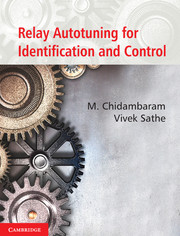Book contents
- Frontmatter
- Contents
- List of Figures
- List of Tables
- Acknowledgements
- Preface
- 1 Introduction
- 2 Improved Autotune Identification Methods
- 3 Cascade Controllers Tuning by Relay Autotune Method
- 4 Simultaneous Relay Autotuning of Cascade Controllers
- 5 A Simple Method of Tuning Cascade Controllers
- 6 Improved Saturation Relay Test for Systems with Large Dead Time
- 7 Identification of FOPTD Model using Single Symmetrical Relay Test
- 8 Autotuning of PID Controllers for Unstable FOPTD Systems
- 9 Autotuning of PID Controllers for Critically Damped SOPTD Systems
- 10 Estimation of SOPTD Transfer Function Model
- 11 Estimation of Five Parameters of Unstable SOPTD Model with a Zero
- 12 Identification of FOPTD Multivariable Systems
- 13 Identification of SOPTD Multivariable Systems
- 14 Tuning of Multivariable Controllers for Non-Minimum Phase Systems
- 15 Tuning of Multivariable Controllers by Genetic Algorithms
- 16 Summary and Conclusions
- Appendix A
- Appendix B
- Appendix C
- Nomenclature
- Problems
- Suggestive Reading
- References
- Index
5 - A Simple Method of Tuning Cascade Controllers
Published online by Cambridge University Press: 05 June 2014
- Frontmatter
- Contents
- List of Figures
- List of Tables
- Acknowledgements
- Preface
- 1 Introduction
- 2 Improved Autotune Identification Methods
- 3 Cascade Controllers Tuning by Relay Autotune Method
- 4 Simultaneous Relay Autotuning of Cascade Controllers
- 5 A Simple Method of Tuning Cascade Controllers
- 6 Improved Saturation Relay Test for Systems with Large Dead Time
- 7 Identification of FOPTD Model using Single Symmetrical Relay Test
- 8 Autotuning of PID Controllers for Unstable FOPTD Systems
- 9 Autotuning of PID Controllers for Critically Damped SOPTD Systems
- 10 Estimation of SOPTD Transfer Function Model
- 11 Estimation of Five Parameters of Unstable SOPTD Model with a Zero
- 12 Identification of FOPTD Multivariable Systems
- 13 Identification of SOPTD Multivariable Systems
- 14 Tuning of Multivariable Controllers for Non-Minimum Phase Systems
- 15 Tuning of Multivariable Controllers by Genetic Algorithms
- 16 Summary and Conclusions
- Appendix A
- Appendix B
- Appendix C
- Nomenclature
- Problems
- Suggestive Reading
- References
- Index
Summary
A simple method is proposed to design PID controllers (i) for a series cascade control system and (ii) for a parallel cascade control system. The method is based on equating coefficients of the corresponding powers of q and q2 in the numerator to α1 and α2 times that in the denominator of the closed loop transfer function model for a servo problem. This method can be used only when the inner and outer loop transfer functions are known. If these transfer functions are not known, then an identification step needs to be carried out. The method is first applied to design a proportional (P) controller for the inner loop and then to design a proportional plus integral (PI) controller for the outer loop. Performances of the controllers are evaluated for the FOPTD models of the inner loop and outer loop.
Introduction
As stated earlier, cascade control is one of the most popular structures for process control. A cascade control system consists of a primary controller and a secondary controller (refer to Fig. 5.1). Cascade control scheme is used to improve the dynamics response of the closed loop system when the disturbance enters the inner loop or disturbances are present in the manipulated variable. The frequency response method (Edgar et al., 1982) is usually employed to design such controllers. The method involves trial and error graphical method. Krishnaswamy et al. (1990) proposed a tuning chart that predicts the primary controller settings by minimizing the ITAE criterion due to load disturbances on the secondary loop.
- Type
- Chapter
- Information
- Relay Autotuning for Identification and Control , pp. 57 - 78Publisher: Cambridge University PressPrint publication year: 2014



